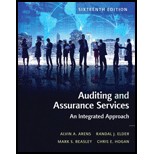
Auditing and Assurance Services (16th Edition)
16th Edition
ISBN: 9780134065823
Author: Alvin A. Arens, Randal J. Elder, Mark S. Beasley, Chris E. Hogan
Publisher: PEARSON
expand_more
expand_more
format_list_bulleted
Question
Chapter 15, Problem 23.3MCQ
To determine
Identify the correct option for the given situation.
Expert Solution & Answer
Want to see the full answer?
Check out a sample textbook solution
Students have asked these similar questions
Accounting solve this question
Dave Ryan is the CEO of Ryan's Arcade. At the end of its accounting
period, December 31, Ryan's Arcade has assets of $450,000 and
liabilities of $125,000.
Using the accounting equation, determine the following amounts:
a. Stockholders' equity as of December 31 of the current year.
b. Stockholders' equity as of December 31 at the end of the next year,
assuming that assets increased by $65,000 and liabilities increased by
$35,000 during the year.
Boston Products has a production budget as follows: May, 19,000 units; June, 22,000 units; and July, 27,000 units. Each unit requires 2.5 labor hours at $10 per hour. What would be the budgeted direct labor cost for June?
Chapter 15 Solutions
Auditing and Assurance Services (16th Edition)
Ch. 15 - Prob. 1RQCh. 15 - Prob. 2RQCh. 15 - Prob. 3RQCh. 15 - Prob. 4RQCh. 15 - Prob. 5RQCh. 15 - Prob. 6RQCh. 15 - Prob. 7RQCh. 15 - Prob. 8RQCh. 15 - Prob. 9RQCh. 15 - Prob. 10RQ
Ch. 15 - Prob. 11RQCh. 15 - Prob. 12RQCh. 15 - Prob. 13RQCh. 15 - Distinguish between the TER and the CUER. How is...Ch. 15 - Prob. 15RQCh. 15 - Prob. 16RQCh. 15 - Prob. 17RQCh. 15 - Prob. 18RQCh. 15 - Prob. 19RQCh. 15 - Prob. 20RQCh. 15 - Prob. 21RQCh. 15 - Prob. 22.1MCQCh. 15 - Prob. 22.2MCQCh. 15 - Prob. 22.3MCQCh. 15 - Prob. 23.1MCQCh. 15 - Prob. 23.2MCQCh. 15 - Prob. 23.3MCQCh. 15 - Prob. 24.1MCQCh. 15 - Prob. 24.2MCQCh. 15 - Prob. 24.3MCQCh. 15 - Prob. 25.1MCQCh. 15 - Prob. 25.2MCQCh. 15 - Prob. 25.3MCQCh. 15 - Prob. 27DQPCh. 15 - Lenter Supply Company is a medium-sized...Ch. 15 - Prob. 29DQPCh. 15 - Prob. 30DQPCh. 15 - Prob. 31DQPCh. 15 - Prob. 32DQPCh. 15 - Prob. 33DQPCh. 15 - Prob. 34DQPCh. 15 - Prob. 35DQPCh. 15 - Prob. 36CCh. 15 - Prob. 37ICA
Knowledge Booster
Similar questions
- Boston Products has a production budget as follows: May, 19,000 units; June, 22,000 units; and July, 27,000 units. Each unit requires 2.5 labor hours at $10 per hour. What would be the budgeted direct labor cost for June? I'm waiting for Answerarrow_forwardneed your help with questionarrow_forwardIt's a general accounting question please answerarrow_forward
- ITS GENERAL ACCOUNTarrow_forwardThe following data relate to direct labor costs for the current period: Standard costs 7,500 hours at $11.20 Actual costs 6,100 hours at $10.00 What is the direct labor rate variance? a. $23,000 unfavorable. b. $7,320 favorable. c. $23,000 favorable. d. $15,680 favorable.arrow_forwardPlease provide answer this general accounting and step by step calculationarrow_forward
- Dillard Company starts the year with $10,000 in its cash account, $10,000 in its equipment account, $2,000 in accumulated depreciation, and $18,000 in its retained earnings account. During the year Dillard sells the equipment for $8,570. After the sale of equipment is recorded, the retained earnings account will have a balance of $_.arrow_forwardVariable costing balance sheet is?arrow_forwardMultiple choice Questionarrow_forward
arrow_back_ios
SEE MORE QUESTIONS
arrow_forward_ios
Recommended textbooks for you
 Auditing: A Risk Based-Approach (MindTap Course L...AccountingISBN:9781337619455Author:Karla M Johnstone, Audrey A. Gramling, Larry E. RittenbergPublisher:Cengage Learning
Auditing: A Risk Based-Approach (MindTap Course L...AccountingISBN:9781337619455Author:Karla M Johnstone, Audrey A. Gramling, Larry E. RittenbergPublisher:Cengage Learning Auditing: A Risk Based-Approach to Conducting a Q...AccountingISBN:9781305080577Author:Karla M Johnstone, Audrey A. Gramling, Larry E. RittenbergPublisher:South-Western College Pub
Auditing: A Risk Based-Approach to Conducting a Q...AccountingISBN:9781305080577Author:Karla M Johnstone, Audrey A. Gramling, Larry E. RittenbergPublisher:South-Western College Pub

Auditing: A Risk Based-Approach (MindTap Course L...
Accounting
ISBN:9781337619455
Author:Karla M Johnstone, Audrey A. Gramling, Larry E. Rittenberg
Publisher:Cengage Learning

Auditing: A Risk Based-Approach to Conducting a Q...
Accounting
ISBN:9781305080577
Author:Karla M Johnstone, Audrey A. Gramling, Larry E. Rittenberg
Publisher:South-Western College Pub